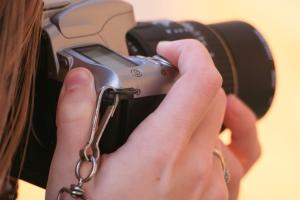A dslr camera: a never-ending love story
A DSLR camera is every pro’s dream, but it’s not only for pros. DSLR stands for digital SLR, or digital single-lens reflex and you would probably recognize the leading brands in this market: Nikon, Canon, and Pentax – all offer a wide variety of models. So how do you choose? How will you know which DSLR camera is best for you and what important factors you should look into? Also, why choosing a DSLR camera is more important than you may think? (hint: it has something to do with buying lenses, lens filters, a tripod, flash, and more. It’s what we like to call ‘a love story’).

How to choose a DSLR camera that fits you like a glove
Congratulations! You are going to buy a DSLR camera and finally enter the major league of photography. Be prepared, though, because as soon as you start looking (at the store or online) you will be overwhelmed with options, features, sizes, and models. So how will you know which camera to choose? We worked hard to assemble the most pertinent questions for you.
Keep the following in mind when choosing a DSLR camera
Price: a good starting point is the price you can afford to pay for a DSLR camera. It goes without saying that DSLR cameras are more expensive than simpler cameras (though there are some exceptions to the rule), so set a budget and remember that you will need to include the cost of lenses, batteries (if they’re not included), memory cards, a camera bag, and possibly insurance or an extended warranty.
How will you be using the camera: the first question the associate at the camera store will ask you is: “what are you going to use the camera for?” The actual usage of the camera is very significant in choosing the right DSLR for you. If you are going to take pictures on an off-road trip you will need to get a very sturdy camera, but if you intend on using it for insect photography you will need a completely different camera (one with macro capabilities, a macro lens, and a tripod). If you want to photograph jazz bands in dark and smoky jazz lounges you will need a camera than can handle very sensitive ISO levels.
Camera size: don’t buy a huge camera if your palms are small. Match the size of the camera to the size of your palm and the way you will be shooting (if you use a tripod often then the size of the camera is less important). Hold each DSLR camera you are considering in your hand and find the one that fits you best and has the most comfortable ergonomics.
Photography gear you already own: DSLR cameras need all sorts of gear and equipment – and you may already own some of it. If you have a Nikon flash, you might want to stick with Nikon when buying a new DSLR camera. The most expensive piece of equipment is the lens, so you might want to buy just the camera body if you already have a couple of good lenses lying around at home. Another thing to keep is mind is memory cards – if you already have a few of a certain kind you can make sure that your new camera will use the same (though memory cards are not particularly expensive).
Resolution: the first thing people talk about is megapixels. Resolution (measured in megapixels) is important for picture quality, and critical when making large prints of your photos. So even though resolution is sometimes overly hyped, it’s a significant factor when choosing a DSLR camera.
Other factors: different DSLR cameras have different characteristics and features, which can bewilder even a seasoned photographer. Some examples are: cameras that let you shoot in manual mode and cameras that let you shoot in semi-manual mode, and cameras that work with a manual focus as well as auto-focus. So here are other factors you should keep in mind:
Speed: how many photos can it take per second? This is an important question to ask if you intend on taking action shots of wildlife, sports, and even children.
Maximum shutter speed: DSLR cameras usually have fast shutter speeds, but the more professional models are even faster.
Screen size: DSLR cameras differ in the size of their LCD screens. Check what screen size fits your needs and whether a large screen doesn’t make the camera too bulky.
Dust protection: dust protection can save you a costly visit to the camera lab down the road. Some cameras even have a self-cleaning mechanism for the sensor. Dust protection is well worth it, especially if you live in a dusty region.
Video: video is a relatively new feature in DSLR cameras. If you want a DSLR camera that shoots video, make sure the quality of the video and the audio is high (some can even connect to an external microphone).